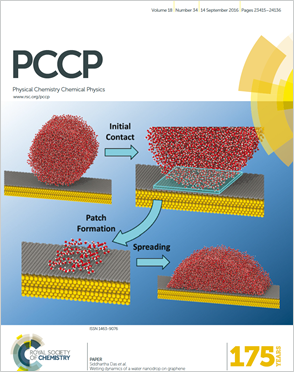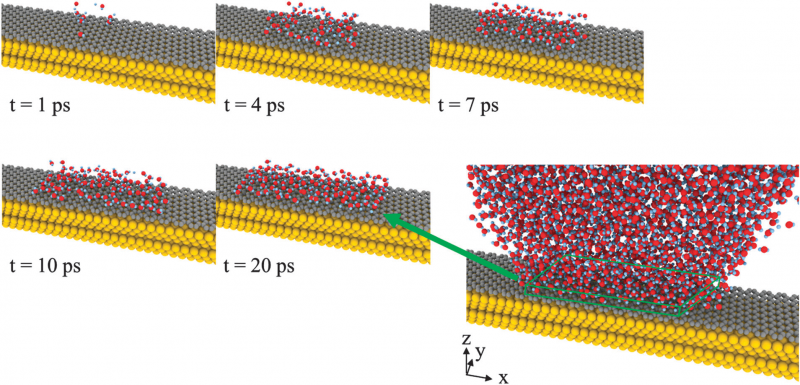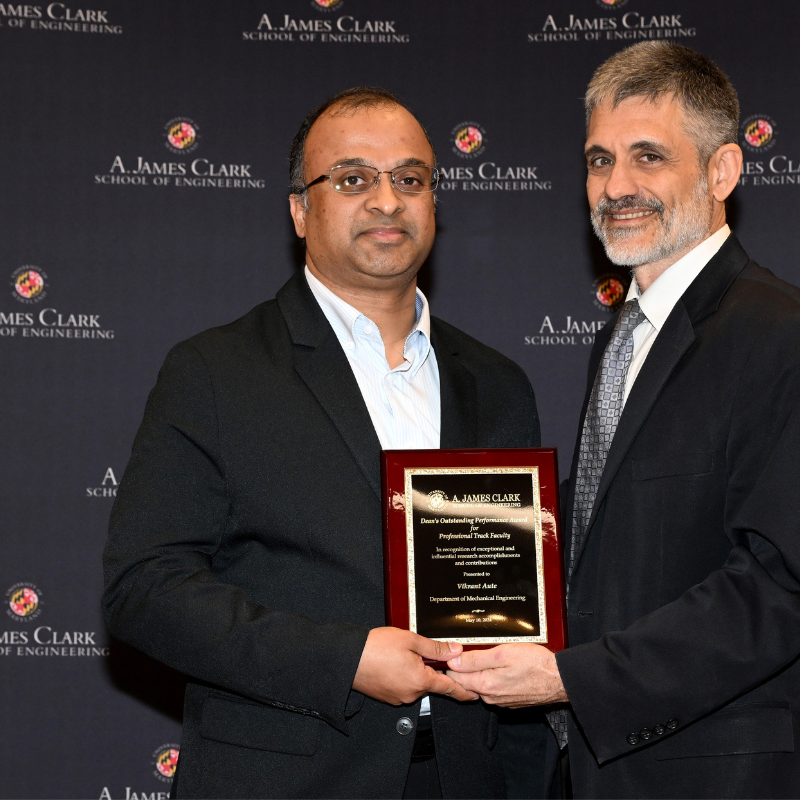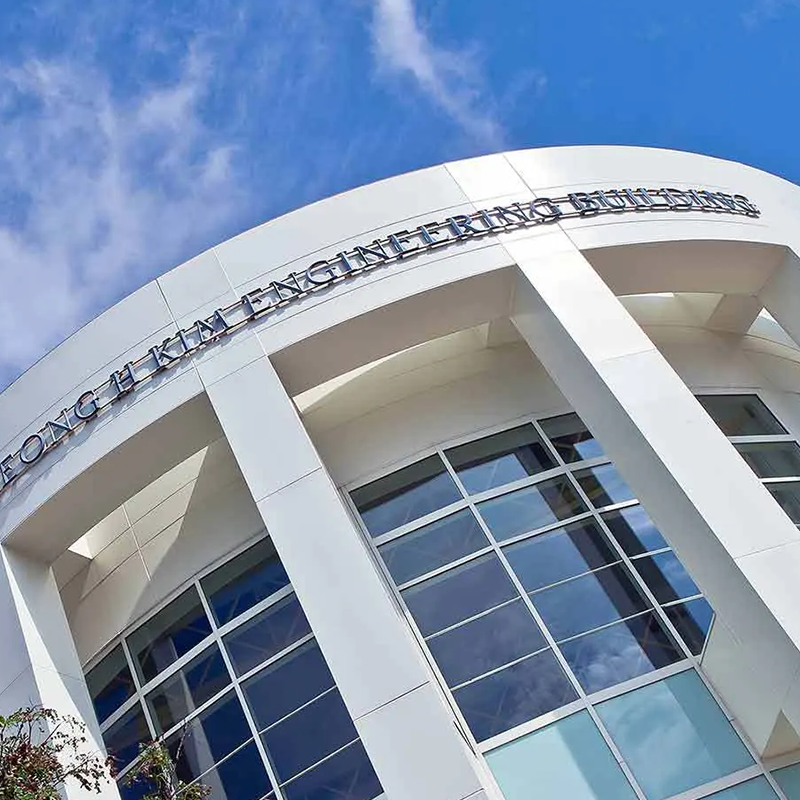News Story
Exploration of Graphene's Wetting Dynamics Could Open New Possibilities in Fluid Mechanics of Two-Dimensional Materials
 A team of student researchers led by Mechanical Engineering Assistant Professor Siddhartha Das, has published new findings on the wetting dynamics of graphene in the journal Physical Chemistry Chemical Physics (PCCP). In addition, their paper, "Wetting dynamics of a water nanodrop on graphene," was highlighted as PCCP's inside front cover article in the September 14, 2016 issue.
A team of student researchers led by Mechanical Engineering Assistant Professor Siddhartha Das, has published new findings on the wetting dynamics of graphene in the journal Physical Chemistry Chemical Physics (PCCP). In addition, their paper, "Wetting dynamics of a water nanodrop on graphene," was highlighted as PCCP's inside front cover article in the September 14, 2016 issue.
Lead author Joseph Andrews completed his B.S. at the University of Maryland (UMD), and recently completed his M.S. in the Department of Mechanical Engineering at UMD under the joint supervision of Das and Associate Professor Peter Chung. Chung along with Das' Ph.D. student Shayandev Sinha were also co-authors on the paper.
Over the past few decades graphene has emerged as a super material in the areas of materials science and physics due to its powerfully unique properties such as being highly elastic, conductive and possessing large thermal and chemical stabilities to name a few.
Graphene's wide-ranging properties have led to its widespread applications across a variety of disciplines ranging from electronics and healthcare to energy and environment. According to their paper, applications such as water desalination, water purification, electromagnetic radiation shielding, development of advanced fabrics, tissue engineering and the fabrication of specialized optical and optoelectronic coating and transparent electrodes, rely on the interactions of graphene with water, and understanding how water interacts and wets a surface coated with graphene layer has tremendous significance.
There has been extensive research on the statics behavior of a water drop on graphene, and existing research has revealed the wetting translucency characteristics of graphene. Wetting translucency refers how a water drop on a graphene layer will show a contact angle depending on the solid beneath the graphene layer.
For example, if a hydrophilic solid—materials that have an affinity for water like gold or glass—is placed below the graphene layer, the water-drop contact angle on the graphene layer will be much smaller, as compared to when a less hydrophilic solid like copper is placed below the same graphene layer. Because of this property, the water-drop contact angle on different numbers of graphene layers is different, as illustrated in Figure 1.

Figure 1: Wetting translucency property of graphene, showing how the nature of underlying solid (bare gold or gold-supported multiple layers of graphene) affect the equilibrium water-drop contact angle. Figure reproduced from Andrews et al., Phys. Chem. Chem. Phys. Vol. 18, pp. 23482-23493, 2016.
While this static, equilibrium picture has been well-studied, the UMD team's paper employs molecular dynamics simulations to shed light on the time evolution (or dynamics) of this process. These dynamics refer to the entire event from when the drop comes in contact with a graphene-coated solid to when the drop attains equilibrium (see Figure 2).

Figure 2: Molecular Dynamics simulation of drop contacting and spreading on monolayer of graphene supported on gold. Figure reproduced from Andrews et al., Phys. Chem. Chem. Phys. Vol. 18, pp. 23482-23493, 2016.
“We have discovered two key facets of drop dynamics on graphene," explained Das. “First, the wetting or spreading starts by the formation of the liquid-molecular patches (as shown in Figure 3) and the rate development of the patches depends on the nature of the solid below the graphene layer. So, the more hydrophilic the underlying solid, the faster the rate of development will be of these patches."
The second issue was how the actual spreading process takes place after this initial patch formation. Spreading refers to the progressive increase, with time, in the contact area made by the drop with the solid as seen in Figure 2. For standard solids, this increase of the contact area— characterizing the spreading—shows a particular time dependence.
Das goes on to explain that what they found most surprising was that during the spreading of water drop on graphene, identical time dependence of the spreading area is recovered.
“Therefore, we can infer that while the statics of wetting of graphene is different from that of the standard non-layered solids due to the wetting translucency effect, spreading isn’t," said Das.

Figure 3: Spreading through patch formation for water drop on gold-supported graphene monolayer. Figure reproduced from Andrews et al., Phys. Chem. Chem. Phys. Vol. 18, pp. 23482-23493, 2016.
“The significance of the present study is that it establishes a framework for studying fluid mechanics of 2-D materials," adds Das. Given the massive surge in interests in graphene and other non-graphene 2-D materials like hexagonal boron nitride, phosphorene, molybdenum disulphide, and others, such a framework could open up more possibilities to explore liquid-2-D-material interactions for discovering new applications and properties of these materials.
Andrews, J. E., Sinha, S., Chung, P. W. and Das, S. "Wetting dynamics of a water nanodrop on graphene." Phys. Chem. Chem. Phys., 2016, 18, 23482-23493 DOI: 10.1039/C6CP01936F
Published August 31, 2016














